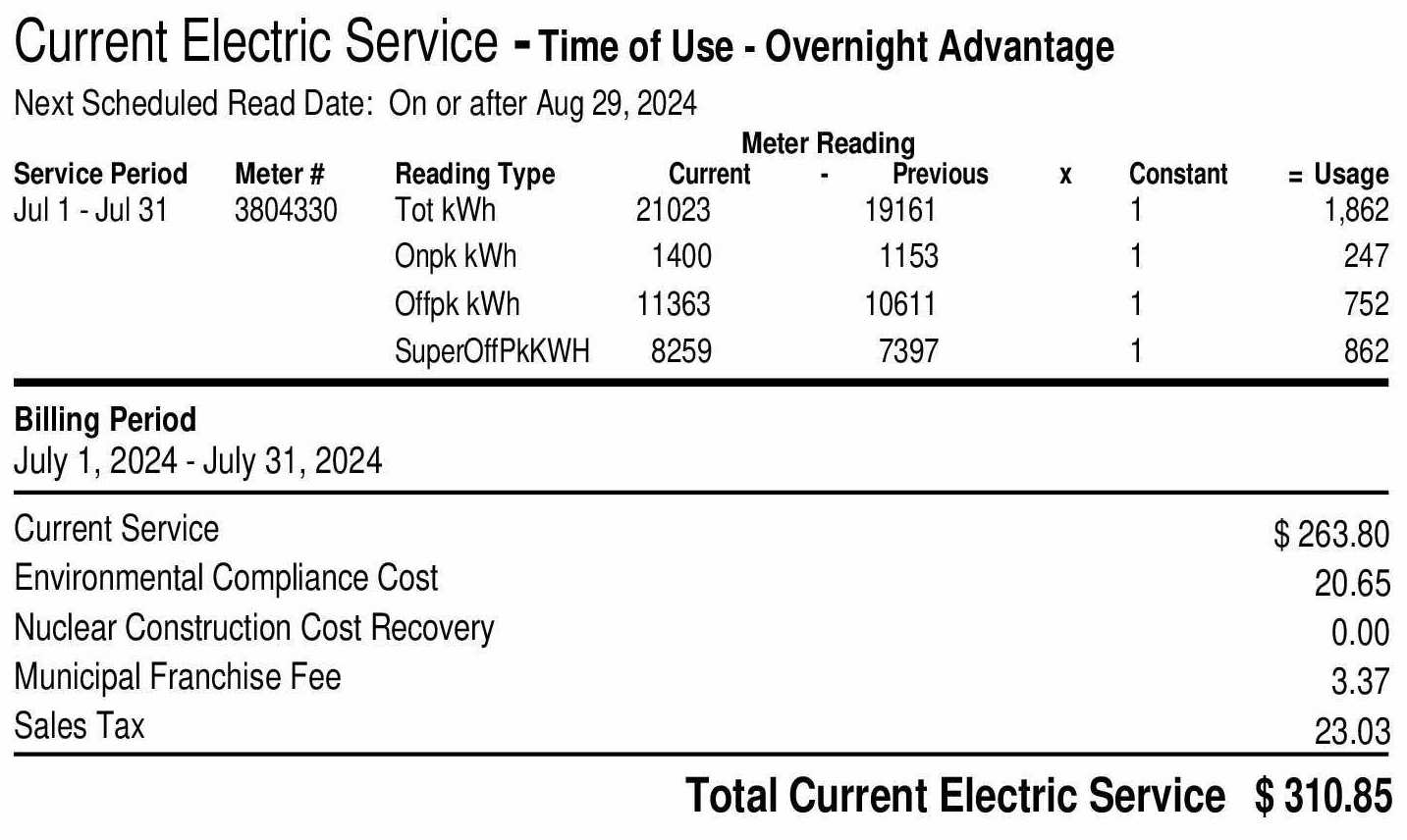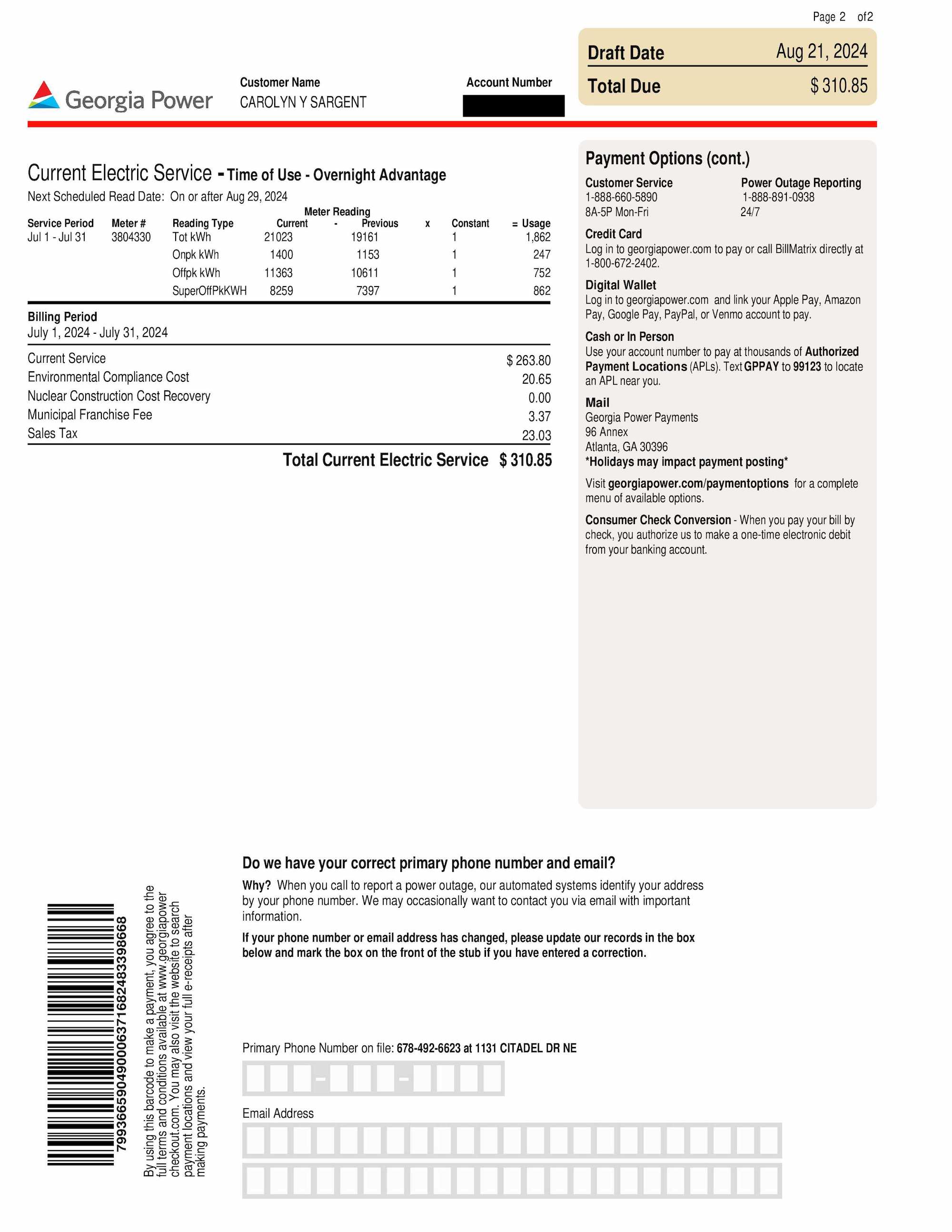Carolyn Yego didn’t know the answer. The Atlanta resident is a biomedical scientist and is used to complex problems, but she couldn’t figure out how Georgia Power calculated her bill.
Yego has Georgia Power’s Overnight Advantage plan, designed for customers who, like her, own electric vehicles or have other batteries to charge. The plan offers low rates from 11 p.m. to 7 a.m. to encourage electric vehicle owners to charge when demand for electricity is low; in Georgia Power parlance, those times are called “super off-peak.” There are also “off-peak” times (7 a.m. to 2 p.m., then 7 p.m. to 11 p.m.) and “peak” times (the peak, most expensive time of the day). (These three times apply only from June to September; the rest of the year, it’s just off-peak and super off-peak.)
Georgia Power residential bills include a “current service” line item, which is the main charge that reflects your electricity usage from the past billing period, followed by several lines for fees and sales taxes. “Where I got totally confused was when calculating my current service,” Yego says. “What I was doing was multiplying the number of hours of usage by the rate plan number and adding them up, but it didn’t equal my current service charge, which was significantly lower.”
But the “current services” section doesn’t just list the cost multiplied by the usage fee. There’s also a “base service fee” that’s charged as a flat rate per day, so Yego added that in. “But there’s still a difference,” she said. When she added up all the fees and taxes, it was less than the amount listed at the bottom of the bill, the amount she had to pay.
Her concerns echo others expressed by readers at Grist, a project working to demystify Georgia’s energy and electricity policy. Through conversations with community members in metro Atlanta, Rome, Augusta and Macon, the most frequent question asked was, “How do I understand my electric bill?”
Below is a breakdown of all the explicit and implicit fees that make up a Georgia resident’s typical monthly electric bill.
Pricing Plans
Georgia Power offers seven rate plans: Overnight Advantage, Flat Bill (Fixed monthly amount averaged over 12 months) Clever Use (This would encourage customers to curb demand, for example, by not running one or more major pieces of equipment during a given 60-minute period).
These are exceptions, however. The vast majority of customers have residential service plans that change their kilowatt-hour rates on a schedule based on the season and, in the summer, on a home’s monthly electricity usage. (The first 650 kWh are charged at a flat rate, and after that the rate increases incrementally.) However, Yeago’s Overnight Advantage plan is slightly different in terms of the kWh rate breakdown, but the rest of this bill is the same as other residential service plans. So if you’re a Georgia Power customer, your bill will probably look very similar to this one.
Carolyn Yego’s bill reads as follows:
Carolyn Yego’s July 2024 Georgia Power bill
Current Services
As Yego noted, the rate structure has two main components: a monthly base charge (a flat rate of $0.4603 per day that covers the cost of meter installation and maintenance), plus a charge based on a household’s usage.
But the “current services” section also reflects other charges that aren’t specifically listed on the invoice, which is what’s confusing Yego.
What else does your current service consist of?

Fuel costs
This is a “rider,” or additional charge, that is rolled into the overall “current service” line item on your monthly electric bill and is not broken out specifically. By law, Georgia Power is allowed to recover all costs it spends on fuel, including coal, natural gas, and uranium for nuclear power. Natural gas makes up 48% of Georgia Power’s fuel mix. As fuel costs, especially natural gas, have risen over the last few years, so has this portion of a customer’s bill. Rates are charged per kilowatt-hour, with different rates at different times of the year. June through September (currently 4.5876 cents per kWh) is higher than October through May (4.2859 cents). Since this bill is for July, Yego paid the higher rate. Multiplying this by his total usage of 1,862 kWh gives him about $85 on his bill.
Demand Side Management Schedule
It covers the administrative costs associated with a residential energy efficiency program. It is assessed as a percentage of the base charge, i.e. the sum of the basic service charge and daily usage.

Environmental Compliance Costs
Georgia Power says the fee is “to recover capital and operation and maintenance costs associated with government-mandated environmental costs.” In other words, it covers federally mandated climate-friendly practices like scrubbers at coal-fired power plants, as well as cleanup costs associated with coal ash, a by-product of combustion. The Public Utilities Commission allowed Georgia Power to pass on the legally required costs of coal ash cleanup to customers. Currently, environmental compliance costs are calculated at just under 12 percent of the base rate, with about 17 percent of that going toward coal ash cleanup, according to the Commission.
Recovering the costs of building nuclear power plants
The fee was added to customers’ bills to help fund the construction of Units 3 and 4 at Plant Vogtle, a controversial nuclear power plant near Augusta. The fee will accrue from 2011 through the spring of 2024 and will cost an average of Between $4 and $8 They will be added to your regular invoice. Currently, these units are in operation and no fees are being collected, so despite the line items, there are no actual fees listed on Yeago’s invoice. The cost of units 3 and 4 are rolled into your current service fee.
Municipal franchise fee
Franchise fees are money that utility companies pay to local governments for the use and maintenance of public rights-of-way, such as roads and other public spaces. Georgia Power customers pay either a local rate or a non-local rate depending on where they live, with the former being a bit more expensive.
Consumption tax
Georgia’s standard 4 percent tax is added to all retail sales, plus applicable local taxes, which add another 7.4 percent.

Taking into account all these different fees, especially those built into the “current service” line, Carolyn Yego was able to get pretty close to the total that appeared on her bill. One of the things that surprised her the most was the cost of fuel. “I Googled ‘fuel recovery,’ and every single article I found said it was going to cost the average customer $15 or something,” she said. But one of those articles was from early 2023, and fuel costs have risen repeatedly since then. 12 percent in June 2023 aloneLast year, fuel price hikes increased the average customer’s bill by $16. Yego said he knew the fuel cost was included in the bill, “but I had no idea how much it went up.”
In the spring of 2024, these prices prompted some Georgia lawmakers to call on Georgia Power to Provide specific information The company proposed including fuel prices by fuel type on customer bills: coal, natural gas, nuclear and solar. The company opposed the measure, saying it already provides that kind of data on its bills and on its website. Still, ratepayers like Yego say more information wouldn’t hurt. “This is very difficult because I think if you’re going to offer so many different plans, you need to give customers a way to determine which plan is best for them,” she said.
The study was compiled in collaboration with the South Face Institute, an Atlanta-based sustainability think tank. Resources for Understanding Utility Bill Payments.










/cdn.vox-cdn.com/uploads/chorus_asset/file/25697397/STK071_APPLE_N.jpg?w=150&resize=150,150&ssl=1)
